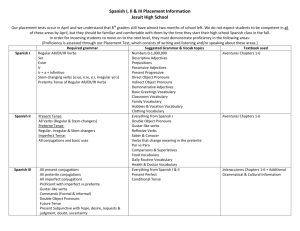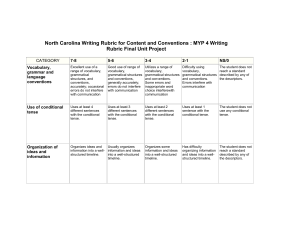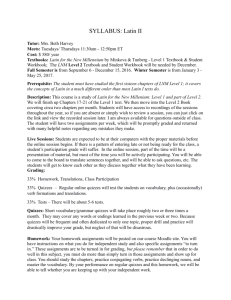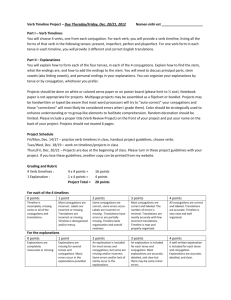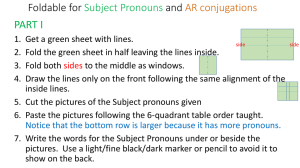Verb Conjugation of Present System Overview! Amo Amare Amavi
advertisement
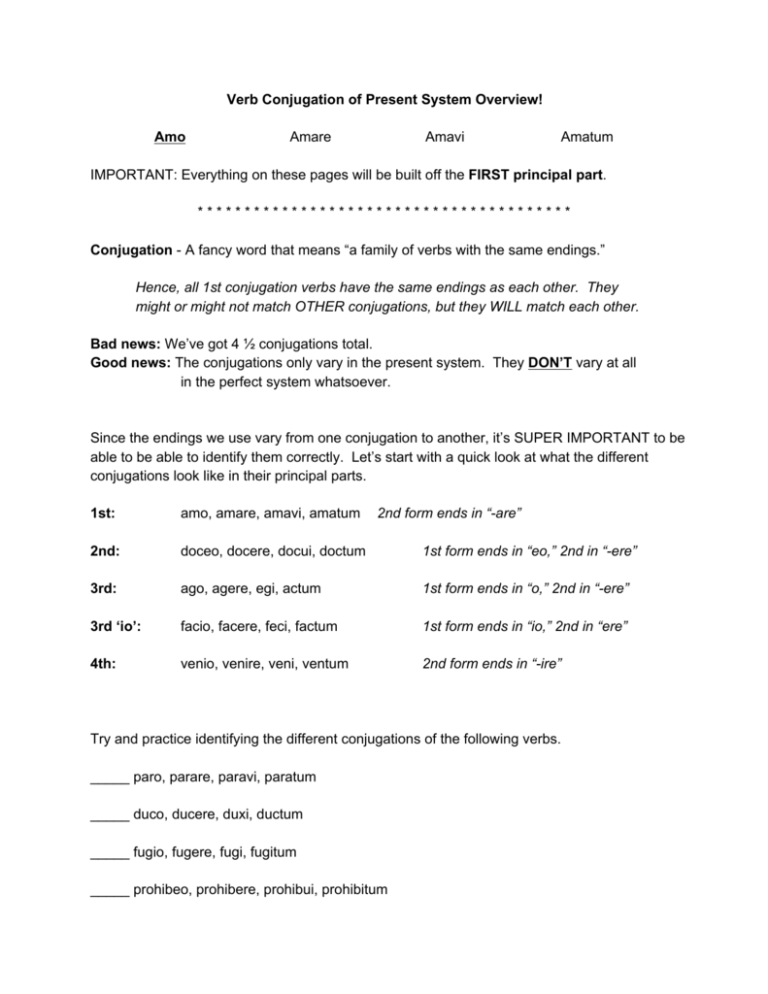
Amo Verb Conjugation of Present System Overview! Amare Amavi Amatum IMPORTANT: Everything on these pages will be built off the FIRST principal part. * * * * * * * * * * * * * * * * * * * * * * * * * * * * * * * * * * * * * * * * Conjugation ­ A fancy word that means “a family of verbs with the same endings.” Hence, all 1st conjugation verbs have the same endings as each other. They might or might not match OTHER conjugations, but they WILL match each other. Bad news: We’ve got 4 ½ conjugations total. Good news: The conjugations only vary in the present system. They DON’T vary at all in the perfect system whatsoever. Since the endings we use vary from one conjugation to another, it’s SUPER IMPORTANT to be able to be able to identify them correctly. Let’s start with a quick look at what the different conjugations look like in their principal parts. 1st: amo, amare, amavi, amatum 2nd form ends in “­are” 2nd: doceo, docere, docui, doctum 1st form ends in “eo,” 2nd in “­ere” 3rd: ago, agere, egi, actum 1st form ends in “o,” 2nd in “­ere” 3rd ‘io’: facio, facere, feci, factum 1st form ends in “io,” 2nd in “ere” 4th: venio, venire, veni, ventum 2nd form ends in “­ire” Try and practice identifying the different conjugations of the following verbs. _____ paro, parare, paravi, paratum _____ duco, ducere, duxi, ductum _____ fugio, fugere, fugi, fugitum _____ prohibeo, prohibere, prohibui, prohibitum Now that we know our conjugations from one another, let’s look at what the different families of verbs actually do! Remember: conjugations only differ in the present system (imperfect, present, and future tenses). First step: The present system personal endings. These are our old friends: ­o/­m ­mus (active) ­s ­tis ­t ­nt And our new friends: ­r ­mur (passive) ­ris ­mini ­tur ­ntur The present stem is the most straightforward. Find the stem of the verb’s 1st principal part, add its present magic vowel (differs based on conjugation), add the personal ending, and you’re done*. Example: 2nd singular present active of amo, amare, amavi, amatum First principal part is amo. The stem is amo. The magic vowel for 1st conjugation is “a.” AM + A + S = AMAS. The conjugations have the following PRESENT magic vowels (THIS LIST IS SUPER IMPORTANT!) 1st: A 2nd: E 3rd: I 3rd “io”: I 4th: I Using this formula, you can make any and every regular present verb in the language. Let’s practice with a few. Conjugate the following: 3rd sg. pres. act. : facio, facere, feci, factum _____________________ 1st pl. pres. pass.: invenio, invenire, inveni, inventum _____________________ 2nd sg. pres. pass.: doceo, docere, docui, doctum _____________________ 2nd pl. pres. act.: paro, parare, paravi, paratum _____________________ Now we’ll switch into the trickiest part of the present system ­ the future tense. The first thing we have to note is that the Magic Vowels change in the future tense for the 3rd, 3rd “io,” and 4th conjugations. Future/Imperfect Magic Vowels: 1st: A 2nd: E 3rd: E 3rd “io”: IE 4th: IE Next, we see that the future tense follows two different sets of rules, depending on conjugation: 1 & 2 conjugations 3, 3io, & 4 conjugations Stem + MV + BI + Pers. Ending* Stem + MV + Pers. Ending Examples: AM + A + BI + T AG + E + T Amabit Aget MON + E + BI + T FAC + IE + T Monebit Faciet All of these examples are future tense, even though they look quite different. As you’ve undoubtedly noticed, the real problem with the future tense is that 3rd conjugation future is identical to 2nd conjugation present! And what’s more, 3rd “io” and 4th future look quite similar (although to a sharp observer, the “i” is a dead giveaway). * One last thing: Latin typically refuses to end verbs with “int,” and will almost always switch the “int” to a “unt.” Hence, words like: agunt and laudabunt. Two exceptions: 3rd “io” and 4th present will become “iunt,” (i.e. faciunt, inveniunt) and future perfect tense (not on this page) will maintain an “int” ending. This means that knowing vocabulary and recognizing conjugations is vital to translate correctly. Let’s work on a few practices and get our legs back under us. In the following, simply identify what word the tense is in. WATCH OUT! Some of these can be tricky. _________________ amabis _________________ moneris _________________ ducetur _________________ facitis _________________ docemus _________________ venient _________________ pararis _________________ agemini _________________ prohibentur _________________ laudo _________________ audis _________________ audes * * * * * * * * * * * * * * * * * * * * * * * * * * * * * * * * * * * * * * * * * * * * * * * * Hard stuff is behind us. The last tense in the present system is the imperfect tense. This one is pretty easy to spot by their “BA,” which appears in all conjugations. The formula for making an imperfect is: Stem + Fut/Imp MV + BA + Pers. Ending AM + A + BA + T VEN + IE + BA + T Amabat Veniebat There are no tricks or exceptions. That’s it. Next step: perfect system, which is much simpler and easier.

